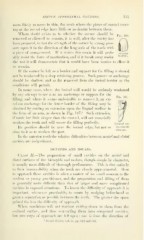Page 233 - My FlipBook
P. 233
SIMPLE APPROXIMAL CAVITIES. 231
more likely to oecur in thin, flat teeth where the plates of enamel meet-
ing at the incisal edge have little or no dentin between them.
Where doubt exists as to whether the corner should be p ,gg
removed or allowed to remain, it is well, after the cavity has
been prepared, to test the strength of the corner by strong pres-
sure upon it in the direction of the long axis of the tooth with
a piece of orange-wood. If it resists this strain it will prob- straight
fracture.
ably resist the force of mastication, and if it break away under
the test it w^ill demonstrate that it would have been unwise to allow it
to remain.
If the corner be left as a border and support for the filling it should
not be weakened by a deep retaining groove. Such groove or anchorage
should be shallow, and as far removed from the incisal border as the
conditions will permit.
In many cases, where the incisal wall would be seriously weakened
by any attempt to use it as an anchorage or support for the
filling, and where it seems undesirable to remove it, an ex-
cellent anchorage for the lower border of the filling may be
obtained by cutting an extension upon the lingual surface in
the form of an arm, as shown in Fig. 187.^ Such extension,
if made but little deeper than the enamel, will not materially
weaken the tooth and will secure the filling perfectly.
Its position should be near the incisal edge, but not so
close to it as to weaken the part.
In the anterior teeth the relative difficulties between mesial and distal
cavities are insignificant.
BICUSPIDS AND MOLAES.
Class H.—The preparation of small cavities on the mesial and
distal surfaces of the bicuspids and molars, though simple in character,
is usually most difficult of thorough performance. This is due entirely
to their inaccessibility when the teeth are closely approximated. How
to approach these cavities is often a matter of no small concern to the
student or young practitioner, and the preparation and filling of them
is generally more difficult than that of larger and more complicated
cavities in exposed situations. To lessen the difficulty of approach it is
important, whenever practicable, to create by wedging beforehand as
great a separation as jiossible between the teeth. The greater the space
gained the less the difficulty of approach.
When conditions will not warrant cutting doM n to them from the
occlusal surface, and thus converting them into compound cavities,
but two ways of approach are left open : one is from the direction of
' Dental Review, vol. ix. pp. 812 and 819.


